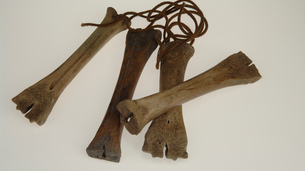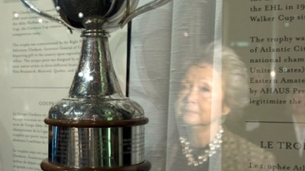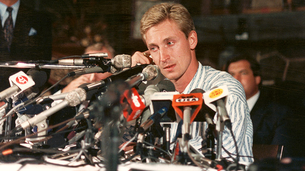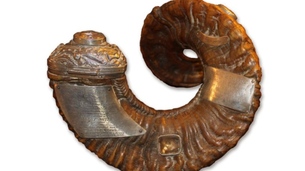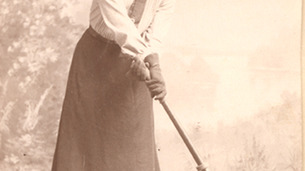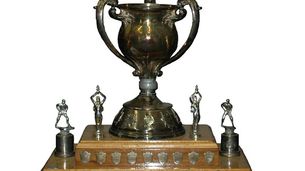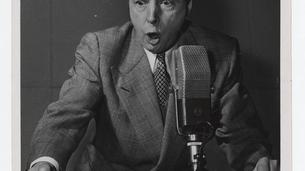| The First International Ice Hockey Game 1886 | ||||||||||||||||||||||||||||||
| He was not a hockey player nor did he have any connection whatsoever with the sport, but when George Longley boarded the Montreal-bound train in Chicago in late February, 1885 he triggered a chain of events that would result in hockey history being made in Burlington, Vermont one year later. | ||||||||||||||||||||||||||||||
| Longley was a Pullman car conductor on the regular Grand Trunk Railway run between the two cities. He was looking forward to finally reaching home, a boarding house in downtown Montreal, especially since he was not feeling at all well. He was suffering feverishness, depression, chills and a cough. By the time the train arrived at Bonaventure Station on February 28, Longley was in no condition to proceed to his lodgings. Doctors succeeded in having him admitted to the crowded Hotel Dieu hospital, although at first they were not certain of the nature of his illness. It turned out to be smallpox, a highly contagious and often fatal disease transmitted through contamination of the air surrounding the victim and by way of infected objects and surfaces such as clothing, furniture and paper. | ||||||||||||||||||||||||||||||
| The failure of the hospital to promptly diagnose the complaint and to isolate the patient resulted in a rapid spread of the disease. Longley himself recovered and returned to his railway duties, but thousands of others were not so fortunate. The first death occurred on April 1. In the following months smallpox reached epidemic proportions and, by the end of its reign of terror, had claimed the lives of more than 3,000 Montrealers — some 2,500 being children under the age of 10 and mostly from working-class French-Canadian homes. Authorities estimated that 12,000 inhabitants of the city’s population of 167,500 contracted the illness. | ||||||||||||||||||||||||||||||
| The commercial and social life of the city was disrupted. Business interests at first wanted newspapers to downplay the seriousness of the epidemic, but later joined forces to combat it by pressing officials to bring in compulsory vaccination and to quarantine those infected. Popular events where large numbers of people gathered were canceled, not the least of which was the Montreal Carnival slated for the winter of 1886. | ||||||||||||||||||||||||||||||
| The annual carnival, inaugurated in 1883, was a huge celebration of the joys of winter sport. Thousands of visitors from all parts of Canada, the United States and even Europe flowed into the city. They filled every hotel room and boarding house. Eagerly, they flocked to the dense program of skating competitions, curling matches, and tobogganing and sleighing demonstrations. In the evenings, there were fancy dress balls and dinners under the patronage of such luminaries as the Governor-General of Canada. Newspaper reporters from Ottawa, Toronto, Winnipeg, Boston, New York, Buffalo, Chicago, St. Louis and points between sent dispatches back home. Among the attractions was a curious new sport called hockey. Most spectators did not know what to make of it. They were dazzled by the game’s speed and the dexterity of the players, but they were also a little taken aback by its rough edge. | ||||||||||||||||||||||||||||||
| By 1885, hockey, in an organized fashion, had been played for 10 years in Montreal, the birthplace of the formalized version as we know it. Even so, most of the city’s inhabitants, not to mention visitors, were unfamiliar with the sport and newspapers struggled to find the right words to describe it. They likened it to rugby, lacrosse and the Irish game of hurley. The carnival, however, gave the game broad domestic and international exposure, a fact not lost on hockey leaders. Most of the participating clubs, such as McGill University, Victorias and Crystals, were locally based. The Quebec Hockey Club entered the first competition in 1883 and the Ottawa Hockey Club played in 1884 and 1885. The newly-formed Montreal Hockey Club joined the scene in 1885. There had never been an American entrant. | ||||||||||||||||||||||||||||||
| The Montreal Club, under the umbrella of the Montreal Amateur Athletic Association, were the 1885 victors. The rapid advancement of the team from inception to championship status was astonishing. Only in November of 1884 had the MAAA board of directors granted permission to one of their members to call a meeting for the purpose of starting a hockey club. Four days later the club was formed and the executive chosen. Two months hence the delighted team presented the carnival trophy to an appreciative board. The secretary-treasurer was immediately instructed to procure a trophy case, and the players anxiously looked forward to defending their title the following season. | ||||||||||||||||||||||||||||||
| But with the smallpox epidemic now causing the cancelation of the 1886 carnival, no one within hockey circles at first knew what to do about maintaining the momentum the carnival tournament afforded the game. As winter approached, there was talk in Ottawa of that city mounting a similar extravaganza since, as the Ottawa Free Press observed, “the smitten metropolis will be compelled this winter to forego its grand annual event.” Soon though, the Ottawa mayor called off those plans, indicating it would be a “dangerous experiment” in light of Montreal’s misfortune. | ||||||||||||||||||||||||||||||
| In Montreal, the carnival committee floated the idea of a “week of sports” as a substitute, presumably to keep it a primarily local affair since the stricken city would hardly be an attractive destination for outsiders. | ||||||||||||||||||||||||||||||
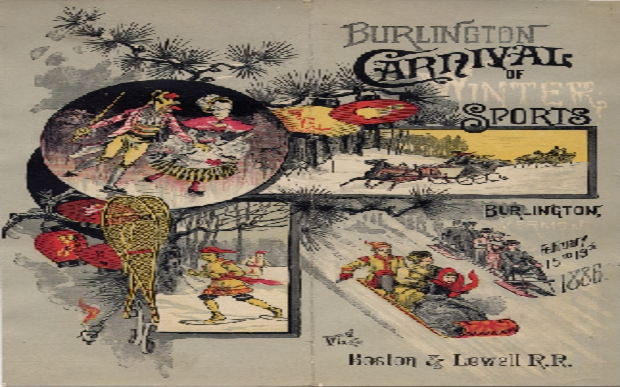
Meanwhile, in the small city of Burlington, Vermont, nestled on the eastern shore of Lake Champlain, local sportsmen were making plans of their own. Members of the Burlington Coasting Club, according to that city’s Free Press, had decided to organize a “week of winter sports, to which all the world should be welcome.” Coasting, later known as bobsledding, was to be a central attraction but other sporting events would be arranged. |
||||||||||||||||||||||||||||||
| Officials were at pains to point out that when they conceived the idea, they were unaware of the cancelation of Montreal’s carnival and, in any event, had in no way intended their own week to compete with that of the “City of the North.” It was only after the Montreal decision, organizers said, that it occurred to them it would be a good idea to borrow the project for a season and have a full-fledged Burlington Winter Carnival. Officials went north to seek advice on the running of such an event, and the Burlington Free Press was able to report that Montreal was being most cooperative “and has not only consented to our borrowing the name and spirit of her carnival, but has generously offered to assist us in every possible way.” | ||||||||||||||||||||||||||||||
| There would be coasting, ice trotting, ice boating, skating races, snowshoe races, tobogganing, concerts, and a grand procession through the main streets. There would be hockey matches at the ice rink. Members of the Montreal Snowshoe Club would be coming down in force, and with them would be two crack Montreal hockey teams, the MAAA and the Crystals. The two teams were already great rivals that year, since they were competing in the Montreal city championship series that had finally been arranged. Everything was set for the week of February 15 to 19. The Ottawa Hockey Club, which had planned to compete, was practicing hard and for the occasion had ordered new sticks from the Caughnawaga reserve. The Ottawas had scheduled a warm-up match en route in Ogdensburg, New York. Mother Nature’s intervention, bringing a blast of unseasonably mild weather, did not ruin plans but necessitated some adjustments. The organizing committee rescheduled the carnival for the following week and the Ottawa team bowed out of the hockey tournament. | ||||||||||||||||||||||||||||||
| The carnival week of February 22 to 26 was indeed all that Burlington could have envisioned. The air was crisp and cold. Retailers advertised suitable attire, including Canadian overshoes and moccasins available at Fisher & Boynton’s Boot and Shoe House, and Canadian tuques and sashes at A.N. Percy & Co. The Free Press put out a special souvenir carnival issue which was distributed to such out-of-state cities as Boston, New York, Troy and Chicago. Somewhat wistfully, the Montreal Gazette told its readers that Burlington was “reaping a rare harvest of pleasure and profit through the success attending the gay gathering there.” | ||||||||||||||||||||||||||||||
| The hockey tournament was the wrap-up sporting event scheduled for the late morning and afternoon of the 26th. Said the Free Press: “Hockey on the ice is one of the prettiest of carnival sports, with the colored costumes of the players, their rapid movements and the feats of skill accomplished.” The paper did its best to picture the object of the players’ attention. “The ball instead of being round is round one way and flat the other,” wrote the reporter before finally nailing down the puck’s description with the deft phrasing “like a boy’s cartwheel sawed out of a board.” | ||||||||||||||||||||||||||||||
|
Competing with the MAAA and the Crystals in the three-team round robin was the local Van Ness House club. The Van Ness House was a prominent Burlington hotel and one of the centers of carnival socializing. Its members had never played a hockey game before and had only a few practice sessions. Nevertheless, in the spirit of athletic competition for which America is renowned, they ventured forth. At stake were gold medals for the members of the winning team and silver for the runners-up.
|
||||||||||||||||||||||||||||||
| The rink was Lake Champlain, specifically the Central Vermont railroad slip. It was protected on three sides by docks which gave spectators an excellent vantage point. By 1886, organized hockey in Montreal had long been an indoor game, being played at the magnificent Victoria Skating Rink and the Crystal Rink. In a sense, the Canadian teams were returning to their outdoor roots. And the lake suited their American counterparts just fine. A terrific gale off the lake greeted the MAAA and the Crystals as they ventured onto the ice for what would be the first game of hockey ever played in the vicinity. Curiously, the referee and umpires were local residents, but since the rules of the game at that time were few and simple, no previous experience in interpreting and enforcing them seemed necessary. | ||||||||||||||||||||||||||||||
| Just one week earlier the same two teams, with almost exactly the same lineups, had met in the Montreal championship series. On that occasion the Crystals prevailed 3-1, thus setting the stage for a grudge match which, though it would have no bearing on the Montreal series, would give the MAAA a chance to restore their pride. And this they did when, after two scoreless 20-minute games, R. Smith “sent the ball through” to give the MAAA the sudden-death win. Friends of the victors greeted the result with deafening cheers. | ||||||||||||||||||||||||||||||
| At this point, true hockey history was about to be made, for the MAAA seven were now to face the Van Ness club in the first hockey tournament contest involving teams from two countries. The wind blew harder than ever through the frigid slip and gusting snow made visibility poor from the spectators’ docks. Though the local team battled valiantly, again the MAAA came through, this time with a 3-0 victory in two games of 15 minutes duration. They took the gold medal honors. All that was left to be decided was the silver. | ||||||||||||||||||||||||||||||
| Probably because of the merciless weather and a general desire to conclude matters, the Crystals and Van Ness agreed to two 10-minute games to decide second spot. Forward J. McGoldrick of the Crystals scored in the first and that was sufficient, giving his team the victory. Observed the Free Press: “Hockey at once leaped into popularity on the part of those Burlingtonians who witnessed the game.” | ||||||||||||||||||||||||||||||
| The MAAA and Crystals returned to Montreal where unfinished business awaited them the following week. In the match to decide the championship of Montreal, the Crystals defeated their arch rivals by a score of 4-2. They went on to win the championship of Canada in a less-than-conclusive manner when their Quebec City opponents refused to conclude the match due to disputes about player eligibility and rough play. | ||||||||||||||||||||||||||||||
| Meanwhile, the site of the first international tournament, the Vermont Central slip on Lake Champlain, was taken over by hordes of boys practicing their newly-discovered game. | ||||||||||||||||||||||||||||||
|
||||||||||||||||||||||||||||||

